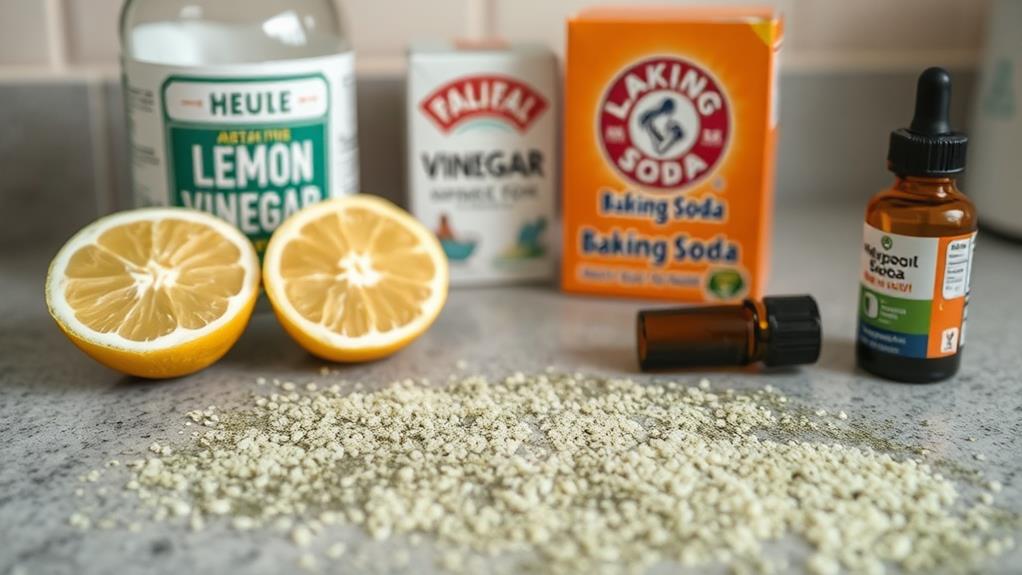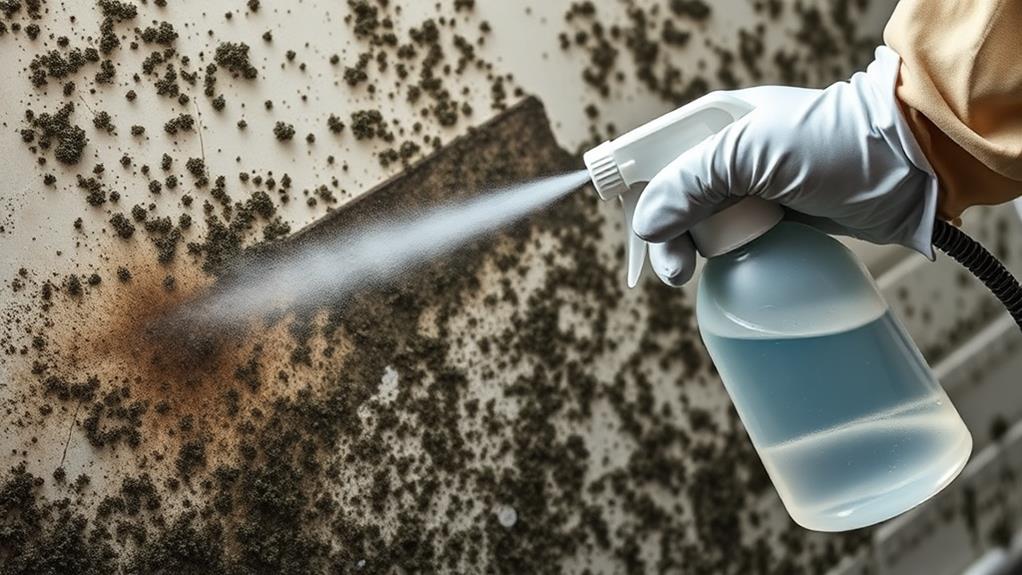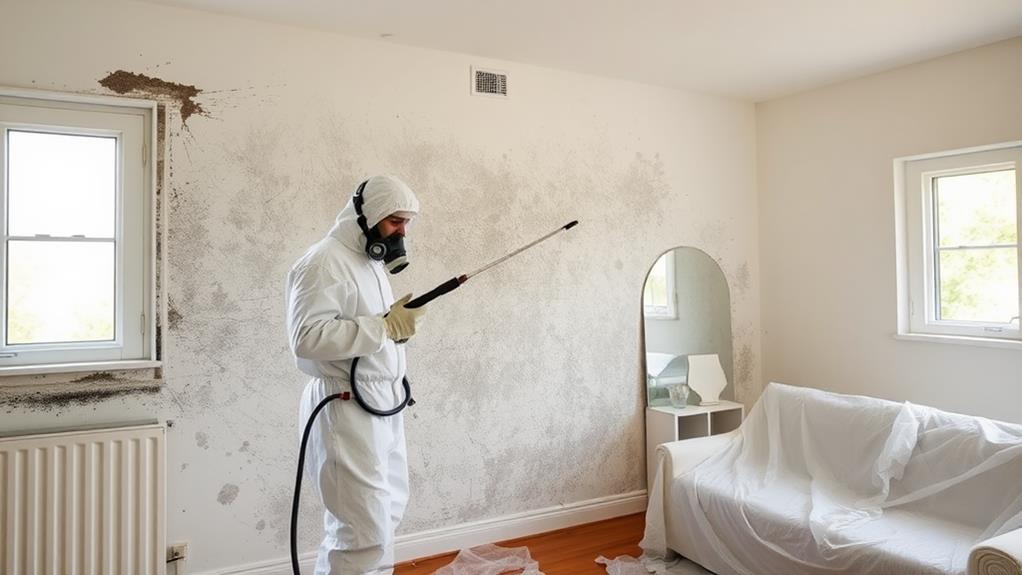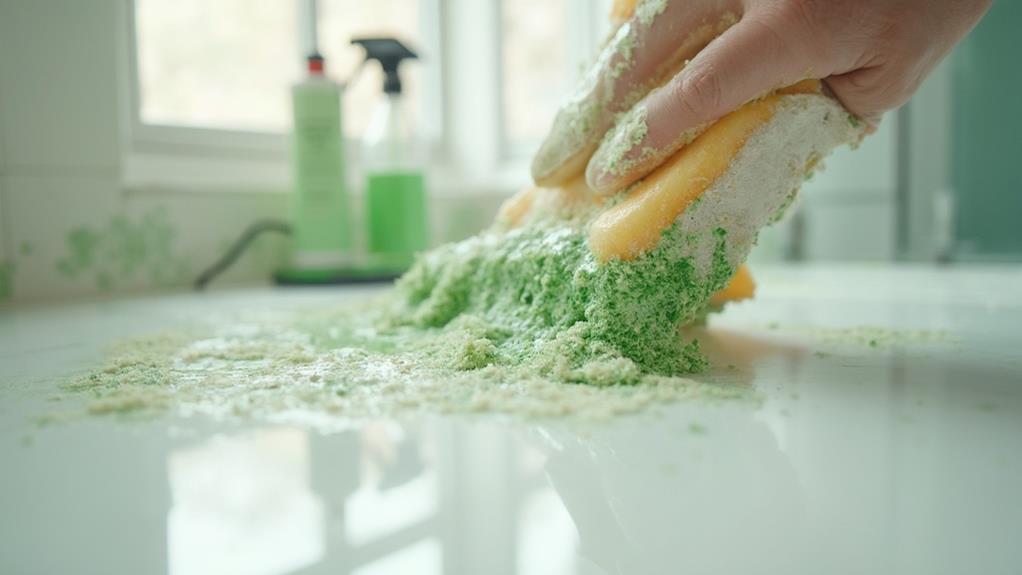Effective mold removal requires a multi-faceted approach using appropriate cleaning solutions. Natural remedies like white vinegar, tea tree oil, and baking soda offer eco-friendly options. Chemical agents, including chlorine bleach and ammonia-based cleaners, provide potent alternatives for non-porous surfaces. Professional-grade products contain higher concentrations of active ingredients for tackling severe infestations. Preventive measures, such as controlling moisture levels and regular maintenance, are crucial for long-term mold management. Proper safety precautions, including wearing protective equipment and ensuring adequate ventilation, are essential during the removal process. Understanding the full spectrum of mold removal techniques can lead to more successful outcomes in combating this persistent problem.
Natural Mold-Fighting Remedies

Harnessing the power of nature, several effective and environmentally friendly solutions exist for combating mold infestations. White vinegar, a versatile household staple, proves highly effective in eliminating mold due to its acetic acid content. Simply apply undiluted white vinegar to affected areas and allow it to sit for an hour before scrubbing and rinsing.
Tea tree oil, known for its potent antifungal properties, offers another natural remedy. Mix one teaspoon of tea tree oil with one cup of water, spray the solution onto moldy surfaces, and let it dry naturally. Baking soda, a mild abrasive with deodorizing qualities, can be combined with water to form a paste for scrubbing mold-affected areas.
Hydrogen peroxide, a powerful oxidizer, effectively kills mold spores. Use a 3% concentration, spray it onto the mold, let it sit for 10 minutes, then scrub and wipe clean. For stubborn mold, a mixture of borax and water can be applied, left to dry, and then vacuumed. These natural solutions not only eliminate mold but also help prevent its recurrence, making them valuable alternatives to harsh chemical cleaners.
Chemical Cleaning Agents
While natural remedies offer effective mold-fighting solutions, chemical cleaning agents provide powerful alternatives for tackling severe or persistent mold problems. These products typically contain active ingredients such as bleach, ammonia, or hydrogen peroxide, which are known for their strong antimicrobial properties.
Chlorine bleach is a common and affordable option, effectively killing mold on non-porous surfaces. However, it may discolor fabrics and should not be mixed with other cleaning agents. Ammonia-based cleaners are another potent choice, particularly for hard surfaces, but require proper ventilation due to their strong fumes.
Hydrogen peroxide solutions offer a less toxic alternative, suitable for a variety of surfaces and capable of penetrating porous materials.
Commercial mold removers often combine multiple chemical agents for enhanced effectiveness. These products may include fungicides, biocides, or specialized surfactants designed to penetrate and eliminate mold at its roots. When selecting a chemical cleaning agent, consider factors such as the type of surface, extent of mold growth, and potential health risks. Always follow manufacturer instructions and wear appropriate protective gear when handling these potent substances to ensure safe and effective mold removal.
Professional-Grade Mold Removal Products

Professional-grade mold removal products offer industrial-strength solutions for severe or widespread mold infestations. These powerful formulations are designed to tackle stubborn mold growth and provide long-lasting protection against future outbreaks. Unlike over-the-counter options, professional-grade products often contain higher concentrations of active ingredients and specialized additives that enhance their effectiveness.
Common ingredients in these products include quaternary ammonium compounds, hydrogen peroxide, and sodium hypochlorite. These substances work by penetrating porous surfaces, killing mold spores, and preventing regrowth. Many professional-grade solutions also incorporate antimicrobial agents that create a protective barrier on treated surfaces.
When selecting professional-grade mold removal products, consider factors such as the type of mold, surface material, and extent of the infestation. Some products are specifically formulated for use on certain materials like wood, concrete, or fabrics. It's crucial to follow manufacturer instructions carefully and use appropriate personal protective equipment when handling these potent chemicals.
While professional-grade products can be highly effective, they may require special application techniques or equipment for optimal results. In severe cases, it's advisable to consult with a professional mold remediation specialist to ensure safe and thorough removal.
Preventive Measures and Maintenance
After addressing severe mold infestations with professional-grade products, it's important to focus on preventing future outbreaks. Implementing preventive measures and maintaining a mold-resistant environment can significantly reduce the likelihood of recurrence.
Control moisture levels by using dehumidifiers in damp areas and ensuring proper ventilation throughout your home. Regularly inspect and repair any leaks in plumbing, roofing, or walls to prevent water accumulation. Clean and dry water-damaged areas within 24-48 hours to inhibit mold growth.
Use mold-resistant products when renovating or building, such as mold-resistant drywall and paint with antimicrobial additives. Keep indoor humidity below 60% and use exhaust fans in bathrooms and kitchens to remove excess moisture.
Perform routine cleaning and maintenance, including regular dusting, vacuuming with HEPA filters, and wiping down surfaces with mold-inhibiting solutions. Pay special attention to areas prone to moisture, such as bathrooms, basements, and windowsills.
Improve air circulation by opening windows when weather permits and using fans to promote airflow. Trim vegetation near your home's exterior to reduce moisture retention and ensure proper drainage away from the foundation.
Safety Precautions During Mold Removal

During mold removal operations, adhering to strict safety precautions is paramount to protect both the individuals performing the cleanup and the occupants of the affected space. Personal protective equipment (PPE) is essential, including N95 respirators, gloves, goggles, and protective clothing to prevent exposure to mold spores and cleaning chemicals.
Proper ventilation is crucial; open windows and use fans to direct airflow outdoors, reducing the concentration of airborne spores.
Containment measures, such as sealing off the affected area with plastic sheeting, help prevent the spread of mold spores to uncontaminated areas. Disposal of contaminated materials should be done carefully, using sealed plastic bags. All cleaning tools and equipment should be thoroughly disinfected after use.
It's important to keep children, elderly individuals, and those with respiratory issues or compromised immune systems away from the work area. If the mold infestation is extensive or involves toxic mold species, professional remediation services should be engaged.
Always follow manufacturer instructions when using cleaning products and never mix different chemicals, as this can create dangerous fumes. After completion, a thorough cleaning of the entire area, including HVAC systems, is necessary to ensure all mold spores are removed.
Frequently Asked Questions
How Long Does It Take for Mold to Grow After Water Damage?
Mold growth can begin within 24 to 48 hours after water damage occurs, given favorable conditions. However, visible mold may take 3 to 12 days to appear, depending on factors like temperature, humidity, and surface material.
Can Mold Grow on Synthetic or Man-Made Materials?
Investigating mold growth reveals an intriguing truth: synthetic and man-made materials are not immune. Mold can indeed grow on these substrates, given suitable conditions such as moisture, warmth, and organic matter present on the surface.
Are Certain Types of Mold More Dangerous Than Others?
Yes, certain types of mold are more dangerous than others. Some species, like Stachybotrys chartarum (black mold) and Aspergillus, can produce mycotoxins that pose serious health risks, especially to individuals with respiratory issues or weakened immune systems.
How Does Mold Affect Indoor Air Quality and Health?
Mold can significantly impact indoor air quality by releasing spores and mycotoxins into the environment. This can lead to various health issues, including respiratory problems, allergic reactions, and potential long-term health effects, particularly in sensitive individuals.
Can Mold Come Back After Professional Remediation?
Like a stubborn weed, mold can indeed return after professional remediation. While thorough treatment significantly reduces the risk, recurrence is possible if underlying moisture issues persist or if spores reenter the environment. Regular monitoring and maintenance are crucial.
Conclusion
In the battle against mold, an arsenal of solutions stands ready. From nature's own remedies to chemical warriors and professional-grade weaponry, effective tools abound for vanquishing this unwelcome invader. Like a vigilant sentinel, preventive measures and regular maintenance form a fortress against future infestations. However, safety must be the North Star guiding all mold removal efforts. With these strategies in hand, households can breathe easier, free from the musty specter of mold.

